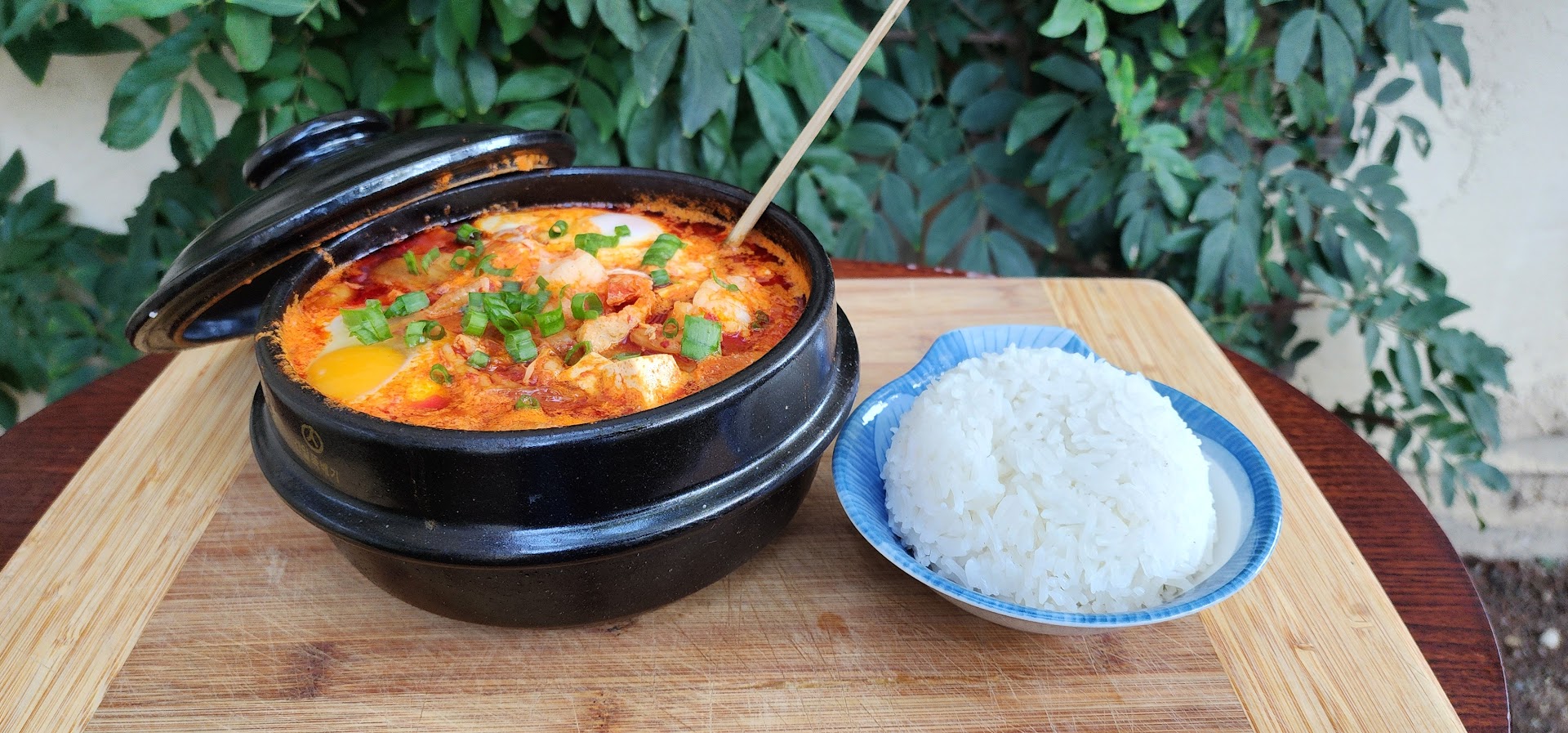Our recipe of the month is Korean Kimchi Haemul Soondubu Jjigae, a slightly spicy Korean soup made with kimchi, tofu, shrimp, and pork belly that is quick and easy to make and has a wonderfully satisfying texture.

Kimchi Haemul Soondubu Jjigae (김치 해물 순두부 찌개), or soft tofu stew, is a beloved Korean dish known for its hearty, comforting nature. It is a jjigae (Korean soup) that features uncurdled tofu, or soondubu, which has a silky, custard-like texture. The dish is typically cooked and served in a hot earthenware pot, which helps maintain its temperature throughout the meal—important because jjigae is best enjoyed piping hot!
This is a great dish to kick off an evening of televised Korean dramas or comedies. Some of our favorite shows are The Extraordinary Attorney Woo, Crash Landing on You (both on Netflix) and on Viki Rakutan, A Korean Odyssey (aka Hwayugi), and My Horrible Boss (aka Ms. Temper & Nam Jung Gi), the show that got us hooked on Korean dramedies!
Soondubu Jjigae is a traditional dish that reflects the simple and resourceful cooking of the past. Tofu, made from soybeans, has been a staple in Korean cuisine for centuries. In times of economic hardship, dishes like Soondubu Jjigae, which required few ingredients, offered a nutritious and affordable meal. Kimchi, Korea's iconic fermented cabbage, brings a punch of tangy, spicy flavor, while also reflecting the importance of fermentation in Korean culinary tradition.
Soondubu Jjigae is often made with a variety of additional ingredients, including pork, beef, or seafood. The contrast of the soft tofu with the spicy broth creates a satisfying balance, making it a popular comfort food across Korea. It's also frequently enjoyed as part of a shared meal, served alongside sticky rice and banchan (side dishes).
Korean soups are often cooked and served in earthenware pots called ttukbaegi. The pots make this a true one-pot meal. However, such pots are a bit expensive here (around $25), so a regular stove top pot is a perfectly fine option.
Cooks notes:
As mentioned above, soondubu is uncurdled tofu. It can be found in Korean grocery stores like H Mart or Zion. Soft or silken tofu can be used as a substitute, but uncurdled tofu is preferred. Unlike tofu sold in tubs, soondubu is often sold in big tubes or soft square packages.
Like many Korean dishes, soondubu Jjigae is eaten with a metal spoon, the head of which is round and somewhat flat. These too are available in Korean markets.
While Korean meals often include numerous side dishes (banchan), one common side dish is a bowl of Korean sticky rice. This rice is softer and has shorter grain than Thai sticky rice. It also does not require soaking.
Many recipes call for either anchovy broth, fish sauce, or both. Fish (such as Thai or Vietnamese) is typically made from fermented anchovies. Anchovy broth is made from dried anchovies and kombu seaweed; it is less strong than fish sauce. You can follow this recipe to make your own anchovy broth, buy it as a pre-made broth, as a powder, or in bouillon cubes or tablets. You can substitute chicken broth with 2 tablespoons of fish sauce.
This recipe calls for fermented Kimchi, most Kimchi sold in Korean markets is fermented. In Korea, kimchi is sometimes fermented in clay pots and buried in the ground for many years. If you keep store-bought kimchi in your refrigerator it will continue to ferment and the taste of the kimchi will deepen in complexity.
Korean pepper powder comes in coarse and fine varieties; this dish uses fine pepper powder to, among other things, to add a nice color to the soup.
Kimchi often comes in big pieces—it needs to be cut smaller. I found that placing it in a measuring up and using scissors to cut up the kimchi is the easiest and least messy way.
This recipe is for two diners. If you want to be the most authentic, spit all the ingredients in half and cook them separately in 2 ttukbaegi earthenware pots.
Ingredients (for 2 servings):
- 1 package of soft tofu (soondubu) (13-18 ounces) or 1 tub of silken tofu cut into cubes.
- 2 cups napa cabbage kimchi, chopped
- 1/4 pound pork belly, thinly sliced
- 4-6 large shrimp either peeled or whole
- 2-3 ounces enoki mushrooms, trimmed and separated
- 2 green onions, chopped with the white and green parts separated
- 2 tablespoons gochutgaru (Korean red pepper powder)
- 4 cloves garlic, minced
- 2 tablespoons sesame oil (we like the toasted variety)
- 2 tablespoons soy sauce
- 2 tablespoons fish sauce (if you aren't using anchovy broth)
- 4 cups anchovy or chicken broth
- 2 eggs
- Salt and pepper to taste
Preparation:
- Sauté the pork belly and garlic: In a Korean earthenware pot (or a heavy-bottomed pot), heat the sesame oil over medium heat. Add the pork belly and sauté until it's no longer pink. Then add the garlic stirring until fragrant, about 1 minute.
- Add Kimchi: Stir-fry for about 5 minutes until the kimchi softens. The kimchi’s tangy flavor will infuse into the meat, creating a base for the stew.
- Incorporate the Spices: Add the gochutgaru, soy sauce, and fish sauce (if you are using it). Stir well to combine, letting the spices bloom in the oil and coat the kimchi and meat.
- Add Broth: Pour in the broth and bring the mixture to a boil. Let it simmer for 5–10 minutes to allow the flavors to meld together.
- Add Tofu: Gently add the soft tofu (soondubu) by scooping it out in large chunks. Add the shrimp. If using silken tofu, cut into 1 inch cubes. Be gentle with the tofu; don't break it up by overly vigorous stirring. Let the tofu simmer in the broth for another 5 minutes.
- Final Touches: Crack an egg into the stew and allow it to cook to your preferred doneness (some like it soft, others fully cooked). Add chopped green onions on top for garnish.
식사를 즐기세요 (sigsaleul jeulgiseyo)
Recipe by T. Johnston-O'Neill
Photos by Shari K. Johnston-O'Neill









